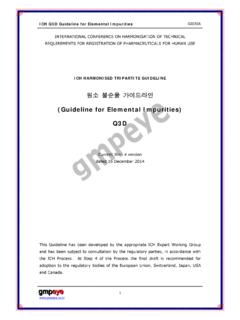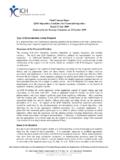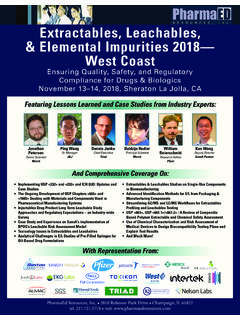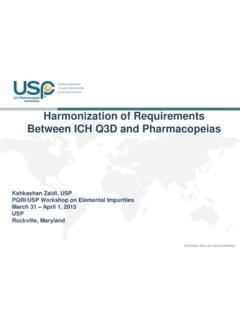Transcription of Q3D Step 5 Elemental impurities
1 30 Churchill Place Canary Wharf London E14 5EU United Kingdom An agency of the European Union Telephone +44 (0)20 3660 6000 Facsimile +44 (0)20 3660 5555 Send a question via our website European Medicines Agency, 2016. Reproduction is authorised provided the source is acknowledged. 25 July 2016 EMA/CHMP/ICH/353369/2013 Committee for Human Medicinal Products ICH guideline Q3D on Elemental impurities Step 5 Adoption by CHMP for release for consultation June 2013 End of consultation (deadline for comments) 31 December 2013 Final adoption by CHMP December 2014 Date for coming into effect For new marketing authorisation applications: June 2016 For authorised medicinal products: December 2017 ICH guideline Q3D on Elemental impurities EMA/CHMP/ICH/353369/2013 Page 2/84 Document History Code History Date Q3D Approval by the Steering Committee under Step 2a. 6 June 2013 Q3D Approval by the Steering Committee under Step 2b and release for public consultation.
2 6 June 2013 Q3D Post sign-off corrigendum in: Table W and Al were removed from the list of included Elemental impurities in Class 2B and 3 respectively. Table the Class for Ni was changed to read 3 instead of 2. 14 June 2013 Q3D Post sign-off minor editorial corrections including: removal of references to Appendix 5 (pgs i deletion of redundant text (pg 4); change of Option 2 to Option 2a (pg 10); insertion of omitted text under Safety Limiting Toxicity (pg 35); removal of duplicated redundant text (pg 41); replacing references to metals in text and metal in Table title with elementals and elements (pg 73); and deletion of header Table (pg 75). 26 July 2013 Q3D Addition of line numbers to facilitate the provision of comments by stakeholders. 30 September 2013 Q3D Approval by the Steering Committee under Step 4 and recommendation for adoption to the ICH regulatory bodies. 12 November 2014 Current Step 4 version Code History Date Q3D Corrigendum to correct: the modifying factor in the text of the safety assessment for Selenium (changed to 2 instead of 10 consistent with Section ); and two references for consistency in the safety assessments for Barium (deleted reference) and Vanadium (revised reference).)
3 16 December 2014 ICH Harmonised Guideline Having reached Step 4 of the ICH Process at the ICH Steering Committee meeting on 12 November 2014, this guideline is recommended for adoption to the regulatory parties to ICH ICH guideline Q3D on Elemental impurities EMA/CHMP/ICH/353369/2013 Page 3/84 ICH guideline Q3D on Elemental impurities Table of contents 1. Introduction .. 5 2. 5 3. Safety assessment of potential Elemental impurities .. 6 Principles of the safety assessment of Elemental impurities for oral, parenteral and inhalation routes of administration .. 6 Other routes of administration .. 7 Justification for Elemental impurity levels higher than an established PDE .. 7 Parenteral products .. 8 4. Element classification .. 8 5. Risk assessment and control of Elemental impurities .. 9 General principles .. 10 Potential sources of Elemental impurities .. 10 Identification of potential Elemental impurities .. 11 Recommendations for elements to be considered in the risk assessment.
4 13 Evaluation .. 13 Summary of risk assessment process .. 14 Special considerations for biotechnologically-derived products .. 15 6. Control of Elemental impurities .. 16 7. Converting between PDEs and concentration limits .. 17 8. Speciation and other considerations .. 19 9. Analytical procedures .. 19 10. Lifecycle management .. 19 Glossary .. 20 References .. 25 Appendix 1: method for establishing exposure limits .. 26 Appendix 2: established PDEs for Elemental impurities .. 29 Appendix 3: individual safety assessments .. 31 Antimony .. 31 Arsenic .. 34 Barium .. 37 Cadmium .. 39 Chromium .. 41 Cobalt .. 43 Copper .. 45 ICH guideline Q3D on Elemental impurities EMA/CHMP/ICH/353369/2013 Page 4/84 Gold .. 47 Lead .. 49 Lithium .. 51 Mercury .. 53 Molybdenum .. 55 Nickel .. 57 Palladium .. 60 Platinum .. 62 Platinum-Group Elements .. 65 Selenium .. 68 Silver .. 70 Thallium .. 72 Tin .. 74 Vanadium .. 76 Appendix 4: Illustrative Examples .. 78 ICH guideline Q3D on Elemental impurities EMA/CHMP/ICH/353369/2013 Page 5/84 1.
5 Introduction Elemental impurities in drug products may arise from several sources; they may be residual catalysts that were added intentionally in synthesis or may be present as impurities ( , through interactions with processing equipment or container/closure systems or by being present in components of the drug product). Because Elemental impurities do not provide any therapeutic benefit to the patient, their levels in the drug product should be controlled within acceptable limits. There are three parts of this guideline: the evaluation of the toxicity data for potential Elemental impurities ; the establishment of a Permitted Daily Exposure (PDE) for each element of toxicological concern; and application of a risk-based approach to control Elemental impurities in drug products. An applicant is not expected to tighten the limits based on process capability, provided that the Elemental impurities in drug products do not exceed the PDEs. The PDEs established in this guideline are considered to be protective of public health for all patient populations.
6 In some cases, lower levels of Elemental impurities may be warranted when levels below toxicity thresholds have been shown to have an impact on other quality attributes of the drug product ( , element catalyzed degradation of drug substances). In addition, for elements with high PDEs, other limits may have to be considered from a pharmaceutical quality perspective and other guidelines should be consulted ( , ICH Q3A). This guideline presents a process to assess and control Elemental impurities in the drug product using the principles of risk management as described in ICH Q9. This process provides a platform for developing a risk-based control strategy to limit Elemental impurities in the drug product. 2. Scope The guideline applies to new finished drug products (as defined in ICH Q6A and Q6B) and new drug products containing existing drug substances. The drug products containing purified proteins and polypeptides (including proteins and polypeptides produced from recombinant or non-recombinant origins), their derivatives, and products of which they are components ( , conjugates) are within the scope of this guideline, as are drug products containing synthetically produced polypeptides, polynucleotides, and oligosaccharides.
7 This guideline does not apply to herbal products, radiopharmaceuticals, vaccines, cell metabolites, DNA products, allergenic extracts, cells, whole blood, cellular blood components or blood derivatives including plasma and plasma derivatives, dialysate solutions not intended for systemic circulation, and elements that are intentionally included in the drug product for therapeutic benefit. This guideline does not apply to products based on genes (gene therapy), cells (cell therapy) and tissue (tissue engineering). In some regions, these products are known as advanced therapy medicinal products. This guideline does not apply to drug products used during clinical research stages of development. As the commercial process is developed, the principles contained in this guideline can be useful in evaluating Elemental impurities that may be present in a new drug product. Application of Q3D to existing products is not expected prior to 36 months after publication of the guideline by ICH.
8 ICH guideline Q3D on Elemental impurities EMA/CHMP/ICH/353369/2013 Page 6/84 3. Safety assessment of potential Elemental impurities Principles of the safety assessment of Elemental impurities for oral, parenteral and inhalation routes of administration The method used for establishing the PDE for each Elemental impurity is discussed in detail in Appendix 1. Elements evaluated in this guideline were assessed by reviewing the publicly available data contained in scientific journals, government research reports and studies, international regulatory standards (applicable to drug products) and guidance, and regulatory authority research and assessment reports. This process follows the principles described in ICH Q3C: Residual Solvents. The available information was reviewed to establish the oral, parenteral and inhalation PDEs. For practical purposes, the PDEs to be applied to the drug product that are presented in Appendix 2 Table have been rounded to 1 or 2 significant figures.
9 A summary safety assessment identifying the critical study for setting a PDE for each element is included in Appendix 3. There are insufficient data to set PDEs by any route of administration for iridium, osmium, rhodium, and ruthenium. The PDEs for these elements were established on the basis of their similarity to palladium. The factors considered in the safety assessment for establishing the PDE are listed below in approximate order of relevance: The likely oxidation state of the element in the drug product; Human exposure and safety data when it provided applicable information; The most relevant animal study; Route of administration; The relevant endpoint(s). Standards for daily intake for some of the Elemental impurities discussed in this guideline exist for food, water, air, and occupational exposure. Where appropriate, these standards were considered in the safety assessment and establishment of the PDEs. The longest duration animal study was generally used to establish the PDE.
10 When a shorter duration animal study was considered the most relevant, the rationale was provided in the individual safety assessment. Inhalation studies using soluble salts (when available) were preferred over studies using particulates for inhalation safety assessment and derivation of inhalation PDEs. Depending on available data, inhalation PDEs were based on either local (respiratory system) or systemic toxicity. For PDEs established for inhalation (and oral or parenteral routes as applicable), doses were normalized to a 24-hour, 7-day exposure. In the absence of data and/or where data are available but not considered sufficient for a safety assessment for the parenteral and or inhalation route of administration, modifying factors based on oral bioavailability were used to derive the PDE from the oral PDE: Oral bioavailability <1%: divide by a modifying factor of 100; Oral bioavailability 1% and <50%: divide by a modifying factor of 10; Oral bioavailability 50% and <90%: divide by a modifying factor of 2; and ICH guideline Q3D on Elemental impurities EMA/CHMP/ICH/353369/2013 Page 7/84 Oral bioavailability 90%: divide by a modifying factor of 1.















